Central Texas Drought Is Worst on Record
Competition for water prompts a quest for new sources.
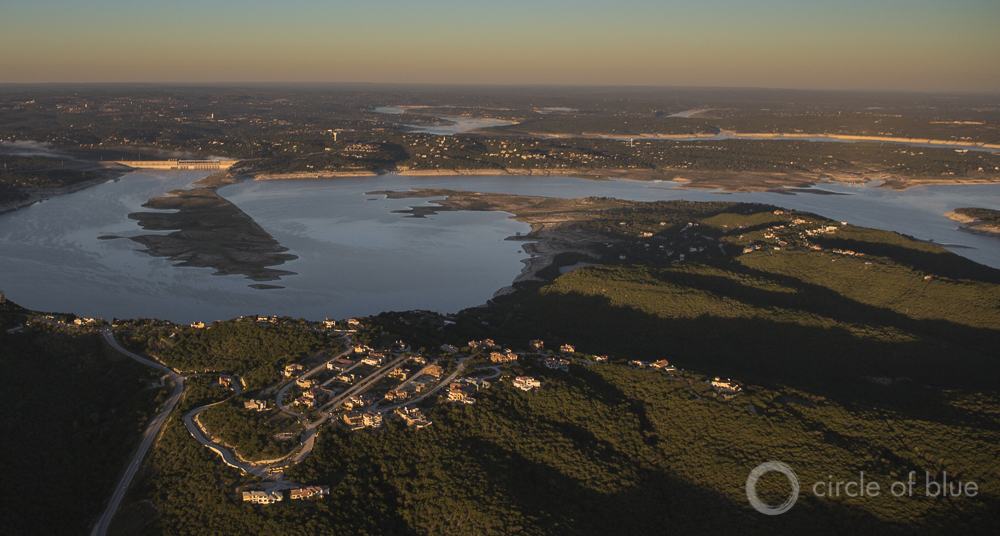
By Brett Walton
Circle of Blue
On February 18, Texas’s Lower Colorado River Authority (LCRA) — a water supplier to power plants and farms, as well as to Austin, the fast-growing capital city in the United States — announced that the deep drought which has gripped the state’s Colorado River watershed since 2008 is the worst on record.
–Joe Beal, general manager (1999-2007)
Lower Colorado River Authority (LCRA)
The two most-populous states in the country — Texas and California, which is also grappling with its own water crisis — now face historic dry periods. The droughts are testing, in new ways, the ability of managers to provide adequate supplies to swelling populations in an era of scarce precipitation.
In Texas, two principles inform the state’s response: use less water and find more.
LCRA’s announcement last week accelerates both responses, several observers told Circle of Blue. The changes in water availability are sharply increasing competition among water users, according to Joe Beal, LCRA general manager from 1999 to 2007.
“The most fundamental change is that suppliers and users are beginning to understand that we are in a drought worse than the drought of record of the 1950s. A scramble for supplies is what is happening in much of Texas over the last three years,” said Beal, who is now a consultant.
Old-timers in Texas, the sun-creased ranchers and the buttoned-downed city folks, speak in biblical terms of that earlier calamity during the mid-20th century; of years of hardship when the bare earth cracked and cattle fell dead in the pastures; of the pulsing disaster that was a touchstone crisis for a whole generation of Texans.
–John Hofman, vice president for water
Lower Colorado River Authority (LCRA)
Like a sharp chest pain, the sudden lack of moisture shocked the body politic and stirred lawmakers from complacency. The encompassing aridity compelled the state to develop a Water Plan, its first attempt to calculate water reserves, anticipate new demands, and direct the flow of money for dams, reservoirs, and canals.
“Nature within the past decade has inscribed upon the wide-spreading Texas landscape grim warnings of greater disasters to come if development of the state’s water resources is neglected,” cautioned the 206-page document, published in 1961.
Indeed, grim days are unfolding again in the Lone Star state. With each passing month, it is clear that the dry post-war decade pales in comparison to the hydrological emergency that Texas now faces. For a state with a thirsty oil and gas industry, six of the 20 largest U.S. cities, and the third-largest agricultural sector, water is again at the top of the political agenda.
A New Standard for Drought
The latest evidence of the drought’s severity came last week. According to LCRA data, the amount of water flowing into the authority’s six Highland Lakes reservoirs during the last seven years is shockingly low: some 60 percent less than from 1950 to 1956, the worst period of that landmark drought. The LCRA reservoirs supply more than 1 million people and 37,00 hectares (91,500 acres) of farmland, as well as the South Texas nuclear power plant in Matagorda County on the Gulf Coast.
Across the state, the pattern is the same: historically hot and dry conditions are draining water supplies and pushing water users to respond:
- Reservoirs in the Panhandle are functionally empty, forcing Amarillo, Lubbock, and San Angelo to rely on new groundwater pipelines.
- Big Springs and Wichita Falls, two smaller cities with reservoirs at the brink of failure, are among the first in the nation to purify sewer water and put it back into the drinking water system.
- Dallas and San Antonio recently approved long pipelines that will tap distant reservoirs and aquifers.
- El Paso and San Antonio are using pressurized membranes for desalination, to turn salty water sweet.
The investments in conservation and efforts to develop new water sources put Texas and its 27 million residents in a better position today than in past droughts, water officials say. And more money is coming.
–Carole Baker, executive director
Texas Water Foundation
In 2013, Texas voters approved a $US 2 billion state water bond. At least 20 percent of the funds are earmarked for conservation projects. The Texas Water Development Board is reviewing the first round of applications for the bond money, $US 800 million of which will be distributed later this year.
Texas also is a leader in water-conservation policies, instituting some of the strictest laws in the nation for assessing leaky pipes, installing high-efficiency plumbing, and preparing for drought.
“We all know that, because of growth in Texas, that we need new water-supply projects,” said Carole Baker, executive director of the Texas Water Foundation, a conservation group, in an interview with Circle of Blue. “But we can defer them with aggressive conservation.”
More Measures Are Needed
Still, the competition for water is intense. Growing by 2 million people in the last four years will do that, as will a patchwork of laws that provide savvy developers with regulatory gaps big enough to build a pipeline through. Heated debate is taking place in Hays County, south of Austin, for example, over a developer’s plan to tap an unregulated area of the Trinity Aquifer to supply growing suburbs.
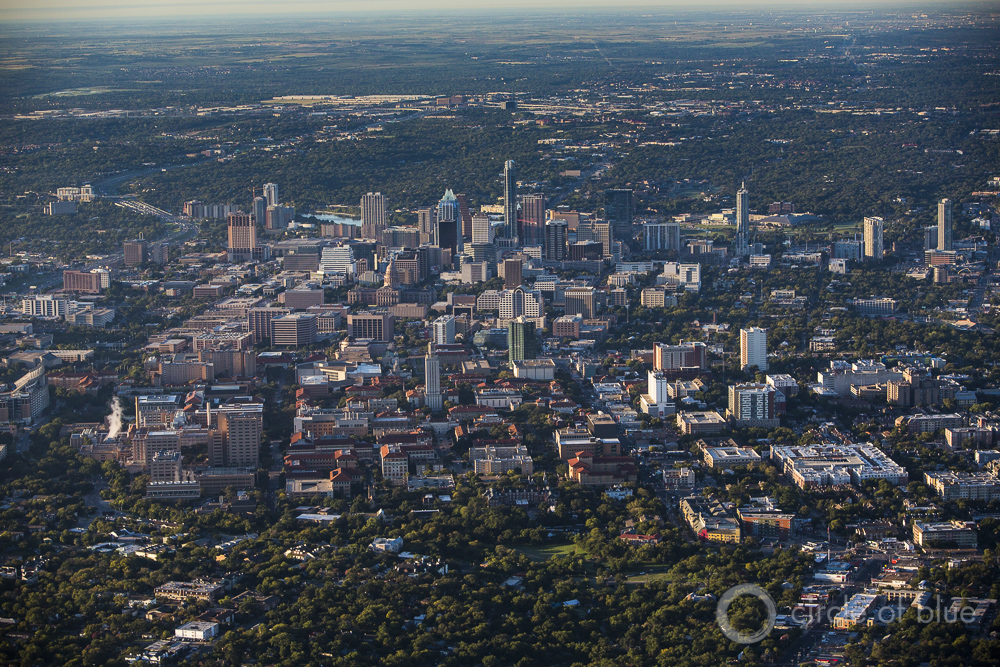
Adding urgency to this race for water in central Texas is LCRA’s announcement, which, in effect, will limit the group’s ability to enter into new water-supply contracts. Reservoir managers will not release more water than is available during the driest periods. A new drought of record means LCRA is reducing — by one-sixth — its estimate of how much water it can reliably supply.
But LCRA still wants to provide water to the booming central Texas region, which is among the fastest-growing in the nation. The five-county Austin metropolitan area added 156,000 people between 2010 and 2013, a 3 percent annual growth rate, according to the U.S. Census Bureau. To meet demands, LCRA is actively pursuing new reservoirs and additional groundwater reserves to bulk up its water-supply portfolio.
“The announcement underscores the need to develop new supplies to accommodate growth in central Texas,” John Hofmann, LCRA executive vice president for water, told Circle of Blue.
Water Providers Are on the Hunt
Falling dominoes are a common metaphor for explaining cascading consequences. One decision influences a second, which causes a third reaction, and so on. Texas water is not a chain of dominoes — there are too many players and potential outcomes.
Instead, the search for new water supplies is more like Twister, the party game based on shifting territorial claims between multiple competitors. In Twister, players stand on a grid of colored circles. As the game progresses, fewer unclaimed spots remain while players twist positions to beat opponents to an open circle.
–Vanessa Puig-Williams
Austin-based environmental attorney
There is a lot of twisting in Texas today for little available water — if one source dries up or is claimed, cities hunt elsewhere for new supplies that will compensate for the loss. The pressure to get more supply is important in light of LCRA’s acknowledgment that its reservoirs hold less reliable water than previously thought, according to Vanessa Puig-Williams, an environmental lawyer in Austin.
“This is a long-term regional problem,” Puig-Williams told Circle of Blue. “It’s not just about the Austin area. It’s a much larger issue.”
Start with the Highland Lakes: these are the six Colorado River reservoirs upstream of Austin that LCRA operates. The authority’s drought announcement means that the actual amount of water available to users — what Texas water suppliers call “firm yield” from the reservoirs — will be cut from 740 million cubic meters (600,000 acre-feet) per year to about 620 million cubic meters (500,000 acre-feet) annually.

That lower amount is closing in on the water supplies that LCRA is obligated by contract to provide.
LCRA today has 519 million cubic meters (420,375 acre-feet) of firm yield contracts, which extend for at least 30 years. Add in water that is reserved for ecosystems and the reductions announced last week, and the authority now has about 62 million cubic meters (50,000 acre-feet) of unclaimed supplies. (An acre-foot is 325,851 gallons or enough water for two to three households per year.)
The main holders of firm yield contracts are cities and industry. Farmers have interruptible contracts, which means that they can be cut off in times of drought. Rice farmers near the Gulf, for example, have received no water from LCRA for the last three years.
LCRA will cut water supplies to cities only if the combined storage of the Basin’s two big reservoirs — Lake Buchanan and Lake Travis — falls below 740 million cubic meters (600,000 acre-feet), which, if dry weather persists, could happen this summer. The result would be a 20 percent reduction in supply and more severe water restrictions for urban residents.
LCRA is responding to the drought like other municipalities, by working to increase its supply. “We’re looking at everything,” Hofmann said.
LCRA, for instance, broke ground in December on a $US 250 million reservoir in Wharton County, near the Gulf of Mexico, that will provide an estimated 111 million cubic meters (90,000 acre-feet) of firm yield when it is completed in 2017. The authority spent $US 15 million in 2013 to acquire up to 12 million cubic meters (10,000 acre-feet) of groundwater in Bastrop County, east of Austin. It spent $US 6.8 million in January for an additional 6 million cubic meters (5,000 acre-feet) in Bastrop County.
Taken together, the projects will add 130 million cubic meters (105,000 acre feet( of water annually to the utility’s water supply, an increase of 20 percent over current supplies.
Hofmann said that LCRA also is investigating a project to remove the salts from brackish groundwater, a form of desalination that some 34 Texas municipalities already use, according to the Texas Water Development Board. The Texas Legislature is so intrigued by the idea of treating brackish water, which the state has in abundance, that the Senate organized a special research committee during last year’s recess to study brackish water’s potential as a new supply source.
Groundwater Is The Prize
Seven dry years, though, expose the vulnerability of reservoirs. The new object of desire is groundwater, which is viewed as a more reliable source. The scramble for groundwater, however, is revealing several striking gaps in Texas water laws, which threaten to undermine groundwater’s reliability and exacerbate water shortages in rivers.
Legal authority for water is splintered to begin with:
- The state has authority over rivers.
- Landowners, by and large, have ownership of the aquifers, and some 100 groundwater conservation districts have the power to regulate aquifer pumping within their boundaries.
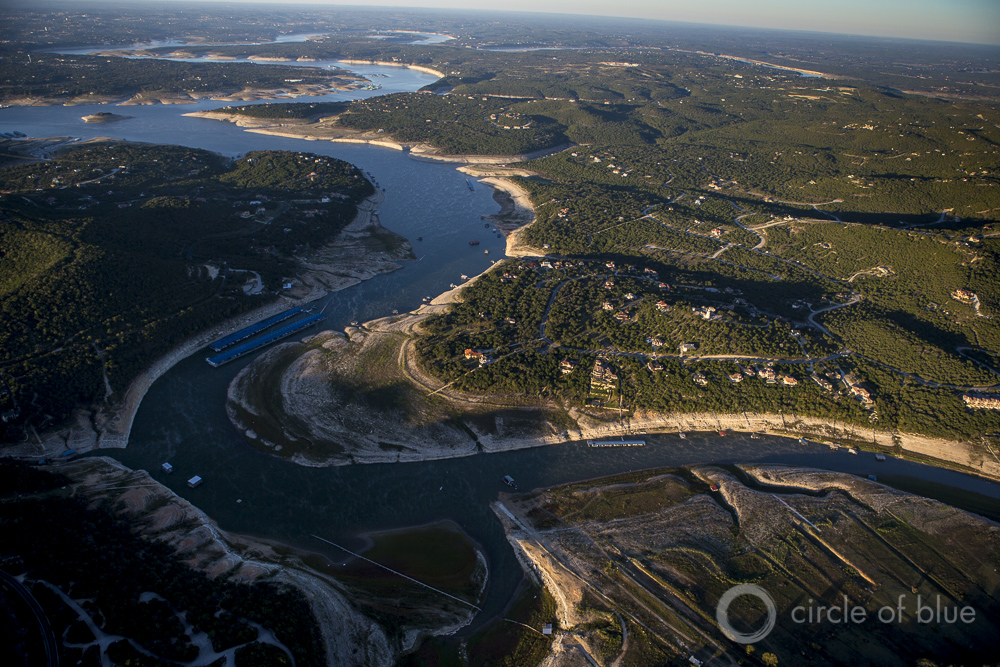
Groundwater law in Texas operates according to a principle called ‘the rule of capture.’ In essence, the doctrine allows a landowner to pump water from beneath his property without limit, even if doing so decreases the water level in a neighbor’s well, stream, or spring. In practice, the groundwater districts can put a cap on pumping within their jurisdictions based on long-term management plans that are unique to each district.
Because the groundwater districts cover most but not all of Texas, unregulated zones exist. Many such zones are targets for water developers, who purchase land to drill high-capacity wells. Or they buy up leases from individual property owners and market the bundle to cities. Val Verde County, on the Mexico border, is one target. Williamson County, north of Austin, is another. The battle of the day, however, is taking place just south of Austin, in Hays County.
A private company is planning to pump 7.4 million cubic meters (6,000 acre-feet) per year from an unregulated section of the Trinity Aquifer that is just outside the boundary of the Hays Trinity Groundwater Conservation District. The water would go to cities and subdivisions elsewhere in the county.
The proposal has drawn criticism from landowners near the well site and from the area’s state representative. In response, Representative Jason Isaac (R), filed a bill that would create an eight-kilometer (five-mile) “buffer zone” around groundwater districts. Any wells proposed for commercial purposes within the buffer would need a state permit, to ensure they harm neither landowners nor the streams and springs that — in this region of porous karst geology — often rely on subterranean water flows.
The battle is the latest example of unresolved legal questions surrounding the rule of capture that neither the courts nor the Legislature wants to touch, Puig-Williams told Circle of Blue. The Texas Supreme Court upheld the doctrine in 1999, leaving it to lawmakers to change.
“The rule of capture is coming to the forefront again,” Puig-Williams explained. “People in Hays County are seeing that, though the rule purports to uphold property rights, it doesn’t really protect them. Large-scale pumping could dry up nearby groundwater sources.”
Brett writes about agriculture, energy, infrastructure, and the politics and economics of water in the United States. He also writes the Federal Water Tap, Circle of Blue’s weekly digest of U.S. government water news. He is the winner of two Society of Environmental Journalists reporting awards, one of the top honors in American environmental journalism: first place for explanatory reporting for a series on septic system pollution in the United States(2016) and third place for beat reporting in a small market (2014). He received the Sierra Club’s Distinguished Service Award in 2018. Brett lives in Seattle, where he hikes the mountains and bakes pies. Contact Brett Walton

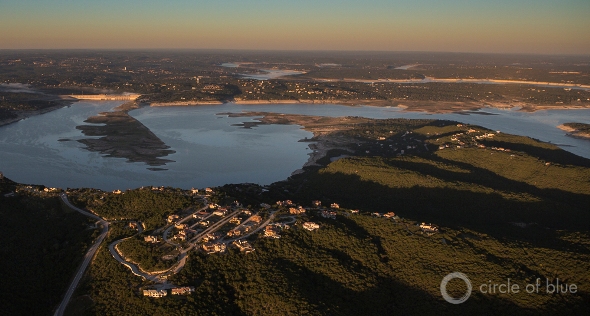

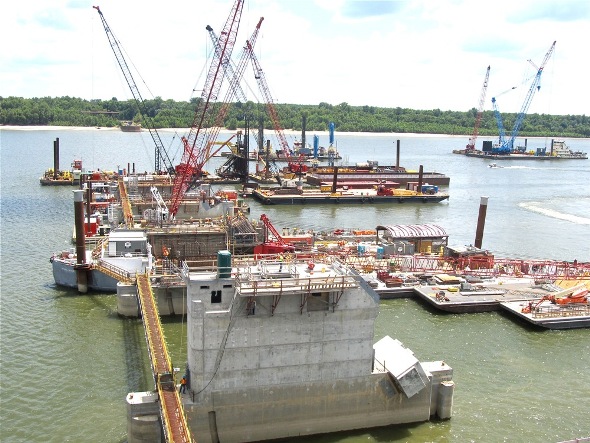
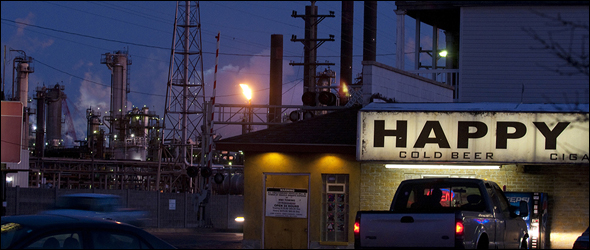
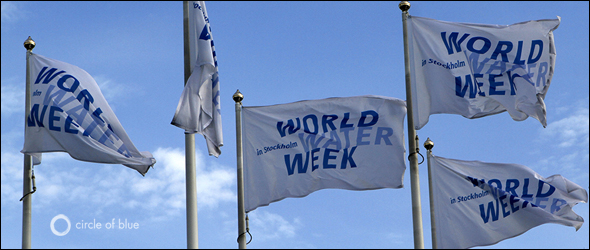
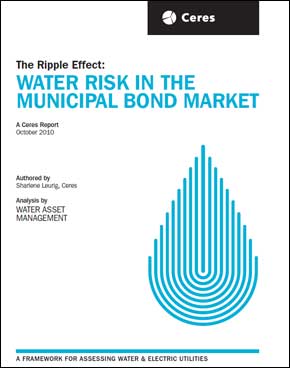


There is another culprit in this problem that isn’t mentioned here. Almost every body of water in my area of North Texas has fracking wells under the water. These wells literally siphon out millions of gallons daily for the water injection process. Why does the media omit this fact when talking about our water shortages?
Lee Ann,
I mention a thirsty oil and gas industry as one of the problems that Texas faces. It is, as you point out, an issue to be reckoned with not only in North Texas with the Barnett shale but in the Eagle Ford and the Permian Basin, which are south and west, respectively. The Colorado River Basin, however, is not a hotspot for drilling activity.
If Austin looses water then no great loss!!! It is noe TEXAS!!! all Austin is is a bunch of socialists and liberals!!!! I live in Northeast Texas and we avoid that place like the plague (Houston, too)!!!!!
When the reasons for moving to Texas disappear, people will stop moving here…. can you say MICHIGAN?. News flash: The people living in the state of Arizona are in fact REAL AMERICANS….meaning you do not have to force St. Augustine grass to grow in any part of Texas. That’s right, 60% of a typical Texans’ treated potable water is sprayed on dirt. Sometimes HOA’s require it, and sometimes the St. Augustine grass grows. What a waste.
No, LCRA isn’t doing “everything”, Mr. Hoffman. It — along with all the other mainstreamers who are “in charge” — has so far not ventured into the same universe as Zero Net Water. Over about the eastern 2/3 of Texas, we have the ability to “grow” water supply in pretty direct proportion with demand, one building at a time. See http://waterblogue.com/2014/01/21/zero-net-water/ for a general review of the Zero Net Water concept. See http://waterblogue.com/2013/02/17/its-the-infrastructure-stupid/, http://waterblogue.com/2014/09/24/this-is-how-we-do-it/, and http://waterblogue.com/2014/10/14/and-stormwater-too/ for insights on how to assemble that sort of 21st century water infrastructure model. But mainstreamers are mainstreamers, from all available information apparently unable to even consider peeking “outside the box”. So we will unsustainably pump down remote aquifers before we’ll even think about whether there is a more sustainable strategy.
Yes and the culprit being geoengineering and chemtrails are not addressed either. Have you noticed the intensity and severity of the drought on the timeline increased when these rogue pilots began spraying us daily from the skies above our heads? This is not conspiracy folks, but fact. The city of Austin permits these pilots to participate in the ongoing chemtrail atrocity in name of climate change and solar radiation management. Look up people, these chemicals being released in the upper atmosphere, whiting out our skies is drying out our precipitation and has manipulated weather patterns and jet streams via haarp technologies and chemtrails. You want to know why the drought is here? Thank your government for allowing nazis to infiltrate our Air Force and selling their souls to chemical companies like Monsanto in the name of climate science. Get your evidence and hard data at geoengineeringwatch.org and download the Skydar alert app and let your Senators know to stop this tyranny in our states!
Did you know that up in British Columbia, Canada our government is giving away fresh water practically for free. Nestle is able to extract one million litres (roughly 250,000 gallons) of fresh, clean groundwater and pays only $2.25. That’s right – only two dollars and twenty five cents.
And that is in Canadian dollars. With the current exchange rate that works out to about $1.98 US dollars.
Most of us living here in the Vancouver area think they should be paying much more. I wish there was a way to transport that water to Texas or California for a price that is fair for all. After all the majority of our fresh fruits and vegetables come from the southern US.